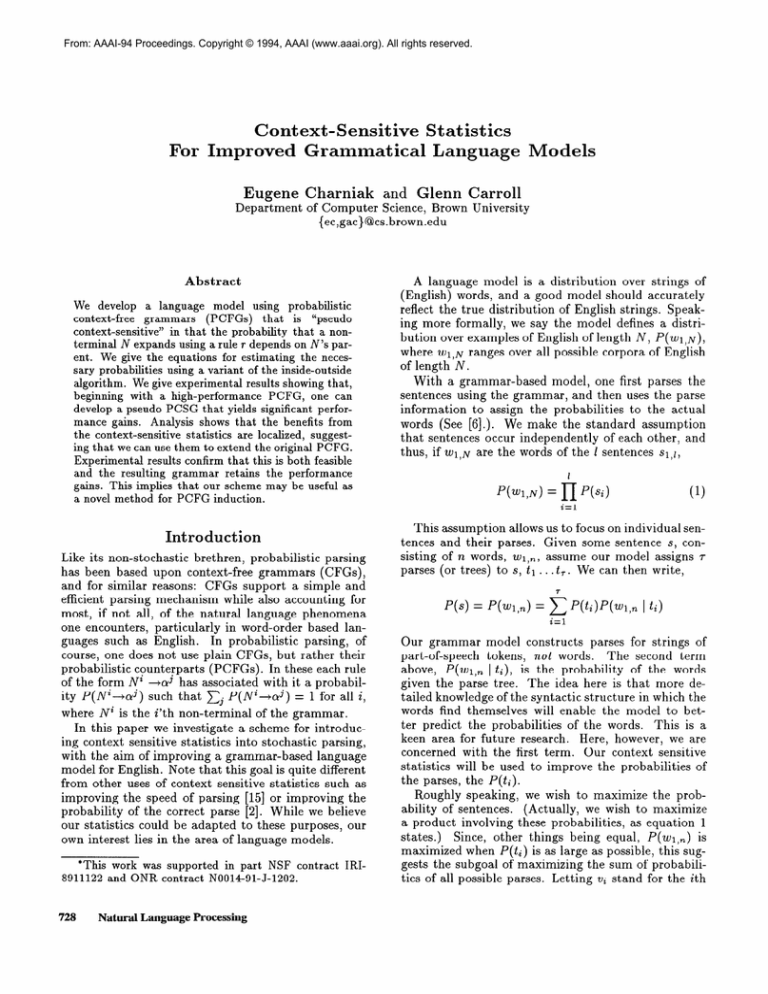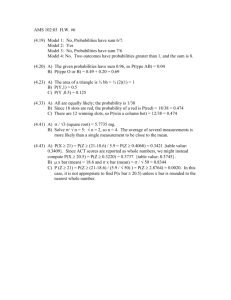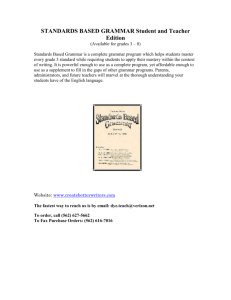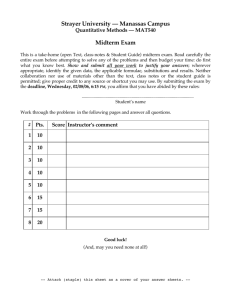
From: AAAI-94 Proceedings. Copyright © 1994, AAAI (www.aaai.org). All rights reserved.
Context-Sensitive
Statistics
For Improved Grammat ical Language
Eugene
Department
Charniak
We develop a language model using probabilistic
context-free grammars (PCFGs) that is “pseudo
context-sensitive” in that the probability that a nonterminal N expands using a rule T depends on N’s parent. We give the equations for estimating the necessary probabilities using a variant of the inside-outside
algorithm. We give experimental results showing that,
beginning with a high-performance PCFG, one can
develop a pseudo PCSG that yields significant performance gains. Analysis shows that the benefits from
the context-sensitive statistics are localized, suggesting that we can use them to extend the original PCFG.
Experimental results confirm that this is both feasible
and the resulting grammar retains the performance
gains. This implies that our scheme may be useful as
a novel method for PCFG induction.
Introduction
Like its non-stochastic
brethren, probabilistic
parsing
has been based upon context-free grammars (CFGs),
and for similar reasons: CFGs support a simple and
efficient parsing mechanism while also accounting for
most, if not all, of the natural language phenomena
one encounters, particularly in word-order based languages such as English.
In probabilistic
parsing, of
course, one does not use plain CFGs, but rather their
probabilistic counterparts (PCFGs).
In these each rule
of the form Ni +c~j has associated with it a probability p(Ni-&)
such that cj p(Ni-&)
= 1 for all i,
where Ni is the i’th non-terminal of the grammar.
In this paper we investigate a scheme for introducing context sensitive statistics into stochastic parsing,
with the aim of improving a grammar-based
language
model for English. Note that this goal is quite different
from other uses of context sensitive statistics such as
improving the speed of parsing [15] or improving the
probability of the correct parse [2]. While we believe
our statistics could be adapted to these purposes, our
own interest lies in the area of language models.
*This work was supported in part NSF contract IRIand ONR contract N0014-91-J-1202.
728
Natural Language
Processing
Carroll
of Computer Science, Brown University
{ec,gac}@cs.brown.edu
Abstract
8911122
and Glenn
Models
A language model is a distribution
over strings of
(English) words, and a good model should accurately
reflect the true distribution of English strings. Speaking more formally, we say the model defines a distribution over examples of English of length N, P(w~,N),
where W~,N ranges over all possible corpora of English
of length N.
With a grammar-based
model, one first parses the
sentences using the grammar, and then uses the parse
information
to assign the probabilities
to the actual
words (See [6].). W e make the standard assumption
that sentences occur independently
of each other, and
thus, if wi,~ are the words of the 1 sentences sl,l,
q-qN)
=
(1)
j--J P(G)
i=l
This
tences
sisting
parses
assumption allows us to focus on individual senand their parses. Given some sentence s, conof n words, wI,~, assume our model assigns r
(or trees) to s, tl . . . t,. We can then write,
P(s)
=
qw,7J
=
x
P(ti)P(w,n
I t;>
i=l
Our grammar model constructs parses for strings of
part-of-speech
tokens, not words.
The second term
of the words
above, P(wI,,
I ii>, is the probability
given the parse tree. The idea here is that more detailed knowledge of the syntactic structure in which the
words find themselves will enable the model to better predict the probabilities
of the words. This is a
keen area for future research. Here, however, we are
concerned with the first term. Our context sensitive
statistics will be used to improve the probabilities
of
the parses, the P(ti).
Roughly speaking, we wish to maximize the probability of sentences.
(Actually, we wish to maximize
a product involving these probabilities,
as equation 1
states.)
Since, other things being equal, P(wl,,)
is
maximized when P(t,) is as large as possible, this suggests the subgoal of maximizing the sum of probabilities of all possible parses. Letting vi stand for the ith
tag
of s, we have
>: Wi) = qvl,n)
(2)
i=l
Equation 2 states that maximizing the sum of the probability of the parses is equivalent to maximizing the
probability of the tag sequence vi,,‘.
Commonly we do
not deal with the probabilities of a language model directly, but rather try to minimize the model’s per-word
cross-entropy.
In the same way, here we try to minimize the per-tag cross entropy of a grammar model.
It can be shown that in the limit this is equivalent to
minimizing
1
-
;
Go
hjP(Vl,n)
For our purposes we simply take the quantity of Equation 3 as the per-tag cross entropy. It seems reasonable
to hope that the probabilities
that minimize the pertag cross entropy would assign higher probabilities
to
more common parses over uncommon ones, and thus,
one would hope, the intended parse over those not intended. Such probabilities
could also be used to guide
the parsing process.
Our own goal is simply to find
ways to maximize this probability, or equivalently, to
minimize the cross entropy.
Besides our differing goals, a distinguishing feature
of this work is that we wish to be able to collect the
parsing statistics without the use of a pre-parsed corpus. While such corpora are, of course, a valuable tool,
they limit the choice of grammars to those that agree
with the parses assigned in the corpus, and the volume
of data available in such form is still quite limited. We
show in this paper how our probabilities
can be collected by an extension of the standard inside-outside
algorithm [1,6].
Pseudo
Context-Sensitivity
In this paper we propose to extend a standard PCFG
by replacing the probability of each context-free rule
with a set of probabilities,
one for each non-terminal
Each of these new probabiliused by our grammar.
ties will reflect the probability of the rule occurring in
a particular context, which in our case is simply the
head of the parent rule. For example in figure 1, the
rule vbg-+adv
vbg has the non-terminal
ii as its parent.
Formally, we write
P(Ni--td
1 p(Ni)
= NS)
(4)
where P(X) is the non-terminal that immediately dominates x its parent. We refer to Ni as the child.
Continuing our example in Figure 1, we would require
P(vbg+adv
vbg
1 p(vbg)
= Ti)
i This equation assumes there is a single tag sequence,
which is true for our data. If there are multiple tag sequences for the sentence, then we are maximizing the sum
of the probabilities of all such sequences, c P(Q,,).
art
adv
Figure 1: Application
n
of a rule within a ii
This is the probability
that we expand vbg, (a verb
phrase headed by an “ing” verb) as an adverb followed
by the verb, given that its parent is Fi, a noun phrase.
Such a situation might occur in the parse of a phrase
like “the slowly dripping faucet.” (The base grammar
for the experiments reported here is modeled after dependency grammars and thus has one non- .terminal for
each terminal in the language.
Here vbg is the nonterminal for the terminal vbg. We use this notation
for all of the examples, although the techniques developed here work for all PCFGs, not just probabilistic
dependency grammars.)
Note that by collecting the statistics of Equation 4
we have not, in fact, moved beyond what is expressible
by PCFGs. The pseudo PCSG can be expanded into a
PCFG roughly as follows. For each parent-child pair,
begin by creating a new non-terminal to represent the
chosen pair. For any rule with the parent as its head,
substitute the new non-terminal for-each occurrence of
the child. For each rule headed by the child, add a
new rule headed by the new non-terminal.
With some
trivial math, one can compute new probabilities for all
the rules in the expanded grammar. We return to this
process later.
Although
technically
we have not moved beyond
PCFGs,
clearly our formalism
has something
of a
context-sensitive
flavor.
We like to think of it as
gathering context-sensitive
statistics for a contextfree grammar, and thus we call our scheme “pseudo
context-sensitivity.”
Clearly, the extra information
provided by context allows us a good deal more flexibility in assigning probabilities to-parses. For example,
while the above rule for vbg would be a not-uncommon
one to find as part of a noun-phrase, consider instead
the following rule for vbg
vbg
+vbg
ii
This rule would be used in “Alice was planting the flowers.” While this rule is a common one at the sentence
level, at the noun-phrase level it would be quite uncommon. Our new probabilities would allow the system to
capture this regularity. As just noted, this regularity
could also be captured through the use of a different
non-terminal
dominating
the gerund.
However, our
new scheme allows us to find and capture such regularities automatically.
To actually use this model requires first that one
can efficiently estimate the probabilities
specified in
Corpus-Based
729
Ew ation 4 and second, that given these probabilities
one can efhciently calculate the probability of a parse.
The second of these is reasonably straight forward, and
we leave it as an exercise for the reader. The former
we cover in the next section.
Calculating
the Probabilities
In this section we show how it is possible to calculate the rule probabilities using a variant of the insideoutside algorithm.
In the generic inside-outside
algorithm one re-estimates the probability of an event e by
seeing how often it occurs in a training corpus. Our
events will be rule invocations,
or uses, in sentence
parses. Typically each sentence in the corpus has many
parses, and it is possible that e occurs zero, one, or
more times in any particular parse. One estimates the
e-counts by adding up, for each occurrence of e the
probability
of the parse in which e occurs, given the
sentence. Our goal in this section is to come up with
the equations for this sum. We show the equations
for the case where the grammar is in Chomsky-normal
form.
We want to count the number of times an event occurs (C(e)).
C(e)
= x
e
P(e
I WA
= q-$---~
,
x
e
P(e,
~1,~)
More specifically, we wish to count the occurrence of
the rule N2 --+Np NQ in the context of Ni NS. The sum
over all possible ways this event could occur includes
(1) the positions Ni, NP, and NQ in the parse, (2)
the position of N” in the parse, and (3) the rule that
relates N” to Ni.
Due to lack of space, we give here only the final
equation. See [7] for the derivation.
C(Ni+NPNq,p(Ni)
I
ph,d
):
a#,
j I,,
k t h,f
P(Ni+NPNq
+a,(~-,
= N”)
=
k)P(Ns+NiNt)P,“(h,j
1 N”)$,(j,
h)P(NS -NiN”)p,“(k
P(Ni+NpNq
1 N’)/$(j,
f)&f
- 1)
+ 1, Ic)
+ 1, h)
f)$(f
+ 1, k)
(5)
In Equation
5 the outside probabilities
(cul(m, n))
should be familiar to those acquainted with the insideThe probabilities
of rules is unoutside algorithm.
changed, except that when we can, we condition on
the parent of the right-hand-side
non-terminal.
We
have also introduced
a new symbol, /3! (j, L), that is
the inside probability &(j, Ic), conditioned on the fact
that the parent of N” is NY. It can be shown that
this last probability is computable in polynomial time
(and, to be specific, in the time required to parse the
sentence).
It is not too hard to see how equation 5 translates
into a form that is not dependent on the CFG being
730
Natural Language
Processing
in Chomsky-normal
form. We omit this transformation for the sake of brevity. The version implemented,
however, is the general one.
Results
Before giving the results it is necessary to establish
some kind of yardstick for performance.
We have suggested above that cross entropy per tag is the right
number, but this figure is not suitable for comparing
competing models.
The difficulty is that it can vary
widely with the training sentences, the tag set used,
and the accuracy of the tagging.
Since an absolute
number is not suitable, we supply comparison figures
between our model and a sort of industrial standard,
the tri-tag model, trained on the same sentences, with
the same tags. (The tri-tag model is one in which each
tag is predicted according to the probability
of getting that tag given the two previous tags.) The tri-tag
model (or often a bi-tag model) has been very successful at language modeling, and is the typical model of
choice in tagging models such as those in [3,8,9,10,13].
What would correspond to a good improvement
in
the cross-entropy
of the tag sequence?
To get some
idea of this we took one of our best pure PCFGs and
generated an artificial corpus from the grammar.
We
then compared the cross entropy the correct grammar
assigned to the tag sequence with that assigned by a
tri-tag model. We found that the correct grammar is
only .15 bits/tag
better than the tri-tag model (2.65
vs 2.80 bits/tag).
In our learning work we have been
aiming at an improvement over tri-tag of about half of
that, in light of the difficulties presented by the complexity of real English, limited availability of data, and
limited computational
resources.
We derived our context-sensitive
grammar from a
PCFG developed from related work on grammar induction. This latter grammar was learned on the basis of a 300,000 word training corpus, consisting of all
sentences in the tagged Brown Corpus [12] of length
less than 23, and not containing certain terminals we
wished to ignore (most notably parentheses, foreign
words and titles). The grammar has 20 non-terminals
and 3500 rules. We built the context sensitive version
of this grammar by applying Equation 5 and training over the same corpus from which the PCFG was
learned.
Our results are obtained using a corpus of
10,000 words drawn from the same source, reserved for
testing.
Both the context-sensitive
and context-free
grammars assigned some parse to 99.5% of the words
in the testing corpus (99.6% of the sentences).
Unparsed sentences are ignored when collecting further
data. As the exact same sentences are unparsed by
both the context-free and context-sensitive
grammars,
and the percentage of unparsable sentences is .4% it
does not seem likely that these sentences are influencing the results given here.
The results of using our context-sensitive
probabilities is shown in Figure 2. In all cases we show the im-
.07
Analysis
-
cl
.05Crossentropy
difference
-
.025-
Context
Free
Crude
-
-
Statistics
Smoothing
Fixed
Fixed
Figure 2: Per-word cross-entropy
of held-out
with/without
context-sensitive
probabilities
data
provement over the tri-tag model, which had per-tag
cross-entropy of 2.738 bits/tag.
(Thus 0 bits/tag in our
graph would correspond to a grammar that is no better or worse than the tri-tag model on average.) The
left-most entry (.039 bits/tag) shows the results we obtained prior to the use of the context-sensitive
statistics. The right-most (.072 bits/tag)
shows what was
obtained after their use. The difference, .033 bits/tag,
is quite large, at least when compared to the goal of a
.075 bits/tag improvement.
The intermediate figures are also of some interest.
The first, labeled “crude,” was obtained getting the
counts for the probabilities
using the viterbi approximation rather than the correct Equation 5. The second, labeled “statistics correct” was obtained using
Equation 5. However, because our context-sensitive
grammar requires so many parameters
(3500 rules
times 20 non-terminals
= 70,000 parameters) we have
to smooth the context-sensitive
probabilities
with the
context-free ones. In the “statistics fixed” version we
smoothed the probabilities using a “seat of the pants”
guess that we would use only the context-free statistics if the combination of N” and N” was seen less than
1000 times, and if more than 1000 we would mix the
context-sensitive
with the context-free probabilities in
the ration .6 to .4. Finding the optimal smoothing parameters gave the right-most, final, figure. As can be
seen, attending to such details does make a difference.
We do not indicate computational
resources expended in context-free vs pseudo context-sensitive
as
there is no significant difference in this regard. The
actual parsing is the same in both cases, the only difference appearing after the parse when calculating the
probabilities
of the tag sequence.
While parsing and
both probabilistic
calculations have big-0 complexity
n3, in fact actual time is dominated by the former, as
the probabilistic
calculations are quite simple.
We now turn to the question of from whence this .033
bits/tag improvement arises. Roughly speaking there
are two possible hypotheses. The first is that the context sensitivity sharpens the probabilities
across the
board.
The second is that there are particular situations where it is important to know the context in
which a rule occurs, and these provide the lion’s share
of the benefit. Our initial hypothesis was that the second of these would prove to be the case. In this section
we offer evidence that this is so.
We start by remembering that for each parent s and
child t there is a distinct distribution for the rules Rt
that expand the non-terminal
t. This distribution is
P(Rt I s,t). It gives the probability that t in the context of s is expanded using each r E Rt. The question
we pose for each s, t pair is “Is P(Rt I s, t) significantly
different from P(Rt I is, t)?” If the difference is large,
then the context sensitive technique is buying us a lot
in the situation in which s is the parent of t.-We estimate significant difference using a likelihood ratio analysis described in [ll].
The data for our estimate are the number of times
that each of the it: rules T E Rt is used when s
is the parent of t, which we designate Cr (s, t) =
for the number of
{Cl,l,
c1,2, * * f , ci,k} , and similarly
times when s is not the parent oft, which we designate
C2(4
=
{c2,1,
We estimate
c2,2, - * *, C2,k).
P(Rt I s, t) using the “obvious”
choice:
(6)
(and similarly for P(ri I is, t)).
Loosely speaking, we compare the
our data, Ci and C2, given that the
distinct, versus the chance of seeing
that the distributions
are really the
the former hypothesis
H(P(Rt
I s, t), P(Rt I -,
chance of seeing
distributions are
the data, given
same. We name
t), Cl, C,)
(7)
In the latter case, we have
H(P(Rt
I t), P(Rt
I t>, Cl,
C2)
(8)
since in this case
P(Rt I s, t) = P(Rt I ls, t) = P(Rt I t)
Finally, following
[ 1 l] we consider the quantity
- log X(s, t) =
H(P(Rt
H(P(Rt
1 t>, P(&
I t), Cl,
C2)
I s, t), P(Rt I ls, t), Cl, C,)
1
(‘)
We lack space to show an exact form for H and
-log+,
t) (b u t see [ll] for details). Intuitively, however, this is a measure of how likely it is that the context sensitive probabilities
for the rules given s, t are
really just the context-free probabilities.
The advantage of this quantity for our purposes is that it can be
Corpus-Based
731
l
5000
lo000
15000
20000
25000
Figure 3: Plot of - log A(s, t) against C(s, t)
computed exactly, starting from the multinomial
distribution,
and thus is accurate even in the presence
of rare events, which, if we may be excused the oxymoron, are quite common in our data. (Many of the
rules occur less than ten times in our data. Thus the
number of times we would expect them to occur with
a particular parent s may well be less than one.)
Note,
also, that in most normal circumstances
- log X(ZZ,t) grows linearly in the number of times s, t
are observed- together, Cl (s, t). Intuitively this captures the idea that more data allows one to make
finer discriminations.
The other contributing factor,
naturally, is the difference between the observed disBecause of
tributions P(Rt 1 s, t) and P(Rt 1 ls,t).
this we decided to plot - log X(s, t) against Ci(s, t),
with one point for each s,t combination.
If the result
were a straight line it would indicate that the various P(Rt 1 s, t) distributions differed to approximately
the same degree from their context-free
equivalents,
P(& 1t), and that the difference in the - logX(s, t)
is just due to having more data for some points, the
larger C(s, t)‘s, than others.
The results shown in Figure 3 are quite different.
While there is clearly a positive correlation between
t), it is hardly a straight line.
Ci(s, t) and -logX(s,
Instead a quick glance at the chart suggests that a
small number of s, t combinations account for the overwhelming majority of the context-sensitive
effect.
To further test this hypothesis,
we modified our
scheme to only use context-sensitive
statistics
for
those
pairs in the top n pairs, when sorted by
- log
t). Figure 4 shows that by the time we have
considered 51 out of the 400 s, t combinations
we have
captured virtually all of the context-sensitive
effect,
and even by 21 s, t combinations
(5% of the data) we
have most (80%) of the effect. This suggests
that our
-initial hypothesis, that the effect is concentrated in a
small number of cases, is basically correct.
Recall that our pseudo PCSG is not truly context732
Natural Language
Processing
Figure 4: Cross entropy
numbers of s, t’s
as a function
of increasing
sensitive, because it does not move out of the range
of languages generated by PCFGs, and it is possible
to “compile out” our context-sensitive
statistics. Since
performance benefits are concentrated in a small number of s, t pairs, and the compilation
procedure can
be carried out incrementally,
on a per s, t pair basis,
the transformation
appears to be practical. The worry
here is that the grammar might be so large as to be useless. Even limiting ourselves to the 20 best s, t pairs,
adding a non-terminal for each pair doubles the number of non-terminals in our grammar, and, in the worst
case, could cause an exponential blow-up in the number of rules. Further, we did not smooth the expanded
grammar as we did for the pseudo PCSG.
Nonetheless, the observed localization
was encouraging, and back-of-the-envelope
calculations suggested
that the expanded
grammar would be only about
10,000 rules, which is a manageable
size.
We carried out the experiment of compiling out the 20 best
s, t pairs and evaluating the performance of the resulting grammar. Ignoring rules with zero probability, the
transformation
added 5384 rules to the existing 3500.
This more than doubles the size, but it was actually
less of an increase than expected. After two iterations
of the inside-outside algorithm, the grammar began to
overfit the training data, but performance reached the
same level as that of the pseudo PCSG. To be precise, the trained PCFG showed an improvement over
the pseudo PCSG of 0.001 bit per word, even though
it had fewer parameters (about 8,000 vs. 17,000). We
do not regard this improvement as significant, but the
fact the PCFG can recover the missing 20% performance gain is very satisfying.
This experiment shows that our scheme can be used
as a novel form of PCFG induction, one which adds
both rules and non-terminals,
and revises the probabilities to produce significantly lower cross entropy.
Adding non-terminals
is a particularly sticky problem
for grammar learners, as the unconstrained space is too
large to search. What is usually done is to fix the number of non-terminals
in some other way, either using
outside sources of information [4], or, as we do, via a
restricted formalism [5]. Another approach, suggested
in [14] is to use a CNF grammar, simply guess an upper
bound on the number of non-terminals,
and deploy a
grammar minimization
procedure periodically
during
the grammar training.
The appeal of our approach
is that it does not require guesses, but can automatically identify a set of promising new non-terminals,
and associated rules and probabilities.
It is, admittedly, highly constrained, but we regard this as more of
a feature than a drawback. Overly large search spaces
require learners to deploy constraints.
Our procedure
is restricted enough to be feasible for a large problem
(English), but 1oose enough to allow significant performance gains.
Conclusion
We have presented a PCFG model in which the probability of a rule also depends on the parent of the
node being expanded.
The scheme is applicable to
any PCFG
and the equations
we have derived allow one to collect the necessary statistics without requiring preparsed data.
In the experiment we ran,
the improvement over the context-free version is quite
large, given the expected range. We have analyzed the
context-sensitive
statistics, and shown that most of the
effect is fairly localized.
This localization
encouraged us to attempt to use
statistics gathered for our pseudo PCSG to extend our
original PCFG. By using the most promising s, t pairs,
we demonstrated that expanding the grammar retains
the performance
gains of the pseudo PCSG, despite
the reduction in the number of parameters.
This implies that our scheme is not only good for improving
performance by means of a pseudo PCSG, but it may
also be viewed as a systematic means for inducing nonterminals, rules, and probabilities for a PCFG.
References
BAUM, L. E. An inequality and associated maximization
technique
in statistical
estimation
for
probabilistic functions of a Markov process. Inequalities 3 (1972), 1-8.
BLACK, E., JELINEK, F., LAFFERTY, J., MAGERMAN, D., MERCER, R. AND ROUKOS, S. Towards
history-based
grammars:
using richer models for
probabilistic parsing. In Proceedings of the 31st Annual Meeting of the Association for Computational
Linguistics. 1993, 31-37.
3. BOGGESS, L., AGARWAL, R. AND DAVIS, R. Disambiguation
of prepositional
phrases in automatically labeled technical text. In Proceedings of the
Ninth National Conference on Artificial Intelligence.
AAAI Press/MIT
Press, Menlo Park, 1991, 155159.
4. BRISCOE, T. AND WAEGNER, N. Robust stochastic parsing using the inside-ouside
algorithm. In
Workshop
Notes, Statistically-Based
NLP Techniques. AAAI, 1992, 30-53.
5. CARROLL, G. AND CHARNIAK, E. Learning probabilistic dependency grammars from labeled text.
In Working Notes, Fall Symposium
Series. AAAI,
1992, 25-32.
E. Statistical
Language
6. CHARNIAK,
MIT Press, Cambridge, 1993.
Learning.
7. CHARNIAK,
E.
AND CARROLL,
G. ContextSensitive Statistics for Improved Grammatical
Language Models. Department
of Computer
Science,
Brown University, CS-94-07, 1994.
8. CHARNIAK, E., HENDRICKSON, C., JACOBSON,
N. AND PERKOWITZ, M. Equations for part-ofspeech tagging. In Proceedings of the Eleventh National Conference on Artificial Intelligence.
AAAI
Press/MIT
Press, Menlo Park, 1993, 784-789.
9. CHURCH, K. W. A stochastic parts program and
noun phrase parser for unrestricted text. In Second
Conference on Applied Natural Language Processing. ACL, 1988, 136-143.
10. DEROSE, S. J. Grammatical category disambiguation by statistical optimization.
Computational
Linguistics 14 (1988), 31-39.
11. DUNNING, T. Accurate methods for the statistics
of surprise and coincidence. Computational
Linguistics 121(1993),
61-74.
12. FRANCIS, W. N. AND KUCERA, H. Frequency
Analysis of English Usage: Lexicon and Grammar.
Houghton Mifflin, Boston, 1982.
13. JELINEK, F. Markov source modeling
eration. In The Impact of Processing
on Communications,
J. K. Skwirzinski,
Dordrecht , 1985.
of text genTechniques
Ed. Nijhoff,
14. LARI, K. AND YOUNG, S. J. The estimation of
stochastic context-free grammars using the InsideOutside algorithm. In Computer Speech and Language. vol. 4, 1990, 35-56.
15. MAGERMAN, D. M. AND WEIR, C. Efficiency, robustness and accuracy in Picky chart parsing. In
Proceedings of the 30th Annual Meeting of the Association for Computational
Linguistics.
1992, 4047.
Corpus-Based
733





